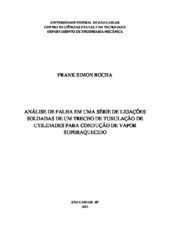| dc.contributor.author | Rocha, Frank Simon | |
| dc.date.accessioned | 2021-12-02T17:48:30Z | |
| dc.date.available | 2021-12-02T17:48:30Z | |
| dc.date.issued | 2021-11-23 | |
| dc.identifier.citation | ROCHA, Frank Simon. Análise de falha em uma série de ligações soldadas de um trecho de tubulação de utilidades para condução de vapor superaquecido. 2021. Trabalho de Conclusão de Curso (Graduação em Engenharia Mecânica) – Universidade Federal de São Carlos, São Carlos, 2021. Disponível em: https://repositorio.ufscar.br/handle/ufscar/15249. | * |
| dc.identifier.uri | https://repositorio.ufscar.br/handle/ufscar/15249 | |
| dc.description.abstract | Process pipes for conducting superheated steam in sugar and energy power plants demand high mechanical strength at high temperatures. The joints between the pipe rod and the connection of this system are mostly satisfied by the welding process, particularized for being single v-groove. Although the performance of the welded connection guarantees mechanical resistance equivalent to the entire tube, a joint is defined as a stress concentrator. Therefore, due to the thermal loads request by the continuous transient regime required by the manufacturing process, the circumferential region that includes weld, Heat Affected Zone (HAZ) and edge metal base is a critical candidate volume to determine the allowable loading and service life of the system. Therefore, this project performs a pragmatic failure analysis in a series of welded connections in a stretch of superheated steam pipe, which suffered longitudinal cracks along the joints. The objective is to identify the mechanisms causing the failures. The results obtained indicated that the thermal expansion of the pipe provided by the operation above the limits adopted in the project can generate stress fields at the material's rupture limit. It was also possible to conclude that the presence of heterogeneities in the weld metal or in the coarse-grained HAZ arising from the manufacturing process can cause nuclear cracks from the deformations generated by thermal loading. Despite the inconclusiveness regarding the mechanism causing the failure, it is possible to say that the results of the study are significant. Furthermore, guidelines were established to perform a second iteration of the failure analysis process aiming at more effective results in future works. | eng |
| dc.description.sponsorship | Não recebi financiamento | por |
| dc.language.iso | por | por |
| dc.publisher | Universidade Federal de São Carlos | por |
| dc.rights | Attribution-NonCommercial-NoDerivs 3.0 Brazil | * |
| dc.rights.uri | http://creativecommons.org/licenses/by-nc-nd/3.0/br/ | * |
| dc.subject | Análise de falha | por |
| dc.subject | Ligações soldadas | por |
| dc.subject | Zona termicamente afetada | por |
| dc.subject | Failure analysis | eng |
| dc.subject | Welding joints | eng |
| dc.subject | Heat affected zone | eng |
| dc.title | Análise de falha em uma série de ligações soldadas de um trecho de tubulação de utilidades para condução de vapor superaquecido | por |
| dc.title.alternative | Failure analisis at a specific site of welded elements in a superheated steam piping system | eng |
| dc.type | TCC | por |
| dc.contributor.advisor1 | Evangelista, Sérgio Henrique | |
| dc.contributor.advisor1Lattes | http://lattes.cnpq.br/1610397432103491 | por |
| dc.description.resumo | Tubulações de utilidades para condução de vapor superaquecido nas usinas de açúcar e energia exigem elevada resistência mecânica em altas temperaturas. As juntas entre vara de tubulação e conexão desse sistema são majoritariamente satisfeitas pelo processo de soldagem, particularizadas por serem de chanfro com penetração total. Apesar do desempenho da ligação soldada garantir resistência mecânica equivalente à do tubo inteiro, a união é definida como concentrador de tensões. Portanto, devido à solicitação de carga térmica dada pelo regime transiente contínuo caracterizado pelo processo fabril, a região circunferencial que contempla cordão de solda, Zona Termicamente Afetada (ZTA) e metal-base de margem é um volume crítico candidato a determinar o carregamento admissível e a vida útil do sistema. Neste sentido, o presente projeto realiza uma análise de falha de forma pragmática em uma série de ligações soldadas em um trecho de tubulação de vapor superaquecido, que sofreram trincas longitudinais ao longo das juntas. O objetivo é identificar os mecanismos causadores das falhas. Os resultados obtidos indicaram que a dilatação térmica da tubulação proporcionada pela operação acima dos limites adotados em projeto pode gerar campos de tensão próximos ou acima do limite de ruptura do material. Também foi possível concluir que a presença de heterogeneidades no metal de solda ou na ZTA de granulação grossa oriundas do processo de fabricação podem nuclear trincas a partir das deformações geradas pelo carregamento térmico. Apesar da inconclusividade relativa ao mecanismo causador da falha, é possível afirmar que os resultados do estudo são significativos. Adicionalmente, foram estabelecidas diretrizes para realizar a segunda iteração do processo de análise de falha com a finalidade de propor medidas para se obter um resultado mais efetivo em estudos futuros. | por |
| dc.publisher.initials | UFSCar | por |
| dc.subject.cnpq | ENGENHARIAS::ENGENHARIA MECANICA::PROJETOS DE MAQUINAS | por |
| dc.publisher.address | Câmpus São Carlos | por |
| dc.contributor.authorlattes | http://lattes.cnpq.br/9055375750542920 | por |
| dc.publisher.course | Engenharia Mecânica - EMec | por |

